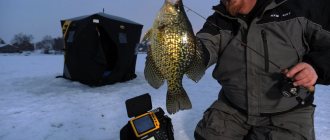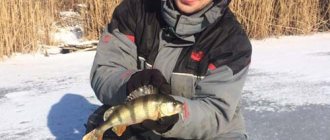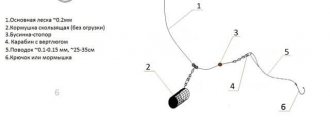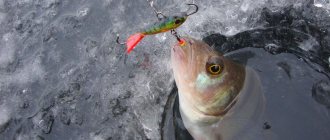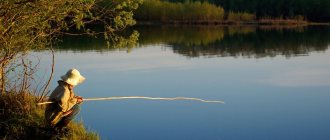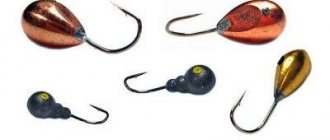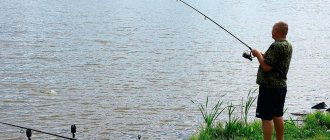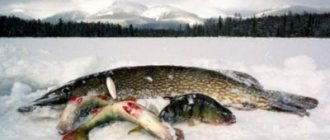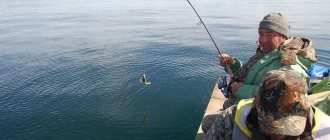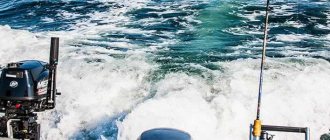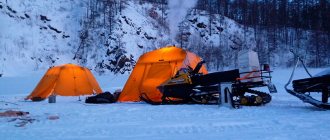Which fishing rod is better to choose for fishing on the first ice?
Structurally, a winter fishing rod will differ from a summer one: first of all, in that the angler is located next to the hole, which means it is much shorter. The handle is larger and should be comfortable to hold. Many fishermen prefer to buy a “balalaika”. This is a fishing rod in which the reel and handle are a single structure. Open coil designs are also often chosen. The material of the fishing rod is an important factor, because the tool will be used at low temperatures.
Basic characteristics:
- Approximate length: 26 cm.
- Material - inside is a fiberglass core or graphite, outside is polyester resin, rubber or other coating that makes the tool light and easy to use.
As for the types of fishing rods, among them are:
- Mormuscular - this is a tool that has a fishing line (diameter 0.06–0.14 mm), a sinker and a jig (tin or lead shot with a hook). When fishing, a jig can be used with or without bait. It depends on the type of prey. When using bait, bloodworms are used.
- Live bait, or zherlitsa is a fishing rod equipped with a support, a nod, a whip, a reel and other equipment. It is used for catching large fish.
- Float - the simplest and most universal.
Fishing rod with float
Every angler has a classic float rod. Its support post is made of wood or plastic. The rod is equipped with a reel and a trigger. The float is attached to a spring at the top of the rod. When a fish bites, it activates. To catch fish you will need bait. Small fish species (minnows, spoons, chubs) can be excellent baits. In addition, bloodworms and raw beef are suitable.
Important! When working with a jig, the fisherman must constantly “play” with the bait, moving the fishing rod, and if it is heavy and the handle is plastic (cold), then the hand will quickly get tired and freeze. Choose a fishing rod with a cork handle.
The type of prey you target will depend on the type of body of water. The fishing technique consists of attaching a float and waiting for a bite. When fishing in the current, you will need to equip the tool with a sinker. It will keep the bait where you want it.
With a nod
A nod is a device that signals the beginning of a bite. It performs the same function as a float. Ideally, an angler should have a collection of nods designed for a specific type of fish and fishing conditions. They are made of polymers and must have excellent flexibility and not break from exposure to low temperatures or mechanical damage. The nod should provide a certain range of motion and manner of playing the jig.
For glitter
A lure is equipped with a fishing rod designed for catching predatory fish. Small spoons are suitable for catching perch, trout, chub, pike and pike perch. The structure consists of a rod, reel, fishing line and spoon. Length - up to 30 cm. Line diameter - 0.25 mm for large fish.
The fishing technique is to lower a spoon to the bottom. The fishing line is fixed at a distance of 15 cm from the ice. The spoon needs to be raised and lowered. Then a pause is made and the cycle is repeated again up to 20 times. Movement time - 2 seconds, pause - 2-5 seconds.
Winter zherlitsa, or bets
A zherlitsa is a special live bait tackle for catching predatory fish. It consists of a reel with fishing line, colored to match the color of water, and a special white hook. On live bait, the hook will be fixed with a special rubber clamping ring. There are 2 types of girders - for over-ice and underwater fishing.
A bet refers to the installation of a stand with a fishing rod. Predatory fish can hunt once every few days in winter. In addition, they await prey in ambush. To catch a predator, you need to place the bait in several places where there are snags and vegetation, among which there may be future prey. If there are no such places, then you need to measure the depth and place the bait where it is deeper.
Important! It is better to choose a float with a slot, since it can be easily removed from the fishing line.
This saves the fisherman from having to put on baits.
fishing line
When completing any winter gear, special attention is paid to the fishing line. Here the monopoly belongs to monophilic models. But not every monofilament line is suitable for ice fishing. The requirements for winter fishing line look different than for summer fishing gear.
- Ice fishing line should be thin. This is explained by clear water, capricious fish and small bait sizes. Many people use fluorocarbon fishing line, which is ideal for the role of both main and leader (it is almost invisible in the water, but there are also disadvantages, such as poor wear resistance and tensile strength).
- However, in winter, large fish are also caught on the hook, so the strength of the fishing line is also important.
- Winter fishing line does not lose softness and strength at low temperatures, unlike summer models.
- An important property of winter monofilament is the lack of memory. The formation of a spiral when stored on the reel will result in poor bite control.
- Friction against the edge of ice places increased demands on winter fishing line in terms of abrasive resistance.
For jig fishing, the thinnest types of fishing lines are used, starting with a diameter of 0.06 mm. However, for ordinary anglers (not athletes), the most suitable thickness will be 0.08-0.12 mm (0.18 mm when fishing with fluorocarbon).
When catching a predator, the fishing line is required to be somewhat thicker. This is explained:
- large fish size;
- with a thick fishing line there is less chance of cutting your hand when fishing for a trophy.
Depending on the size of the expected catch, a fishing line with a diameter of 0.2-0.4 mm is used for lures and fishing rods.
How to choose the right fishing line
The main line is the one with a diameter of 0.14 mm. It is also important how much weight it can withstand before breaking. Given modern materials, it may always turn out that what is visually thin can withstand a greater load.
For example, a line designed for fish weighing 3–5 kg must additionally withstand another 3 kg, taking into account the equipment. For pike, you need a line that holds 6–18 kg of live weight. They also take into account whether the water is standing or moving. The fishing line will be affected by abrasives, water temperature and even the intensity of the current.
The approximate weight of the fish that you need to focus on when choosing a fishing line:
- freshwater - 2–5 kg;
- catfish, pike perch, pike - 6–9 kg;
- sea trout - 7–11 kg;
- tuna, marlin - 14+ kg.
Artificial baits
On sale you can find many types of baits and lures for fishing. Natural ones are considered the most effective due to their familiar texture, smell and color. They are easy to use - just place them on the hook. The most versatile and popular type of natural bait is the earthworm.
But some anglers prefer artificial baits. They are created to imitate prey and its main characteristics: color, shape, movement. These baits are found in many variations in all fishing stores. Experienced fishermen try to take several different species with them in order to cover all the zones in which fish can bite: near-surface, middle of the reservoir and bottom.
Jigs
A jig is an artificial bait. This is a hook inserted into a metal ball or other shaped object. The coating of this ball should attract the attention of the fish: it can be shiny or dark. Luminescent coatings are also commercially available.
The fishing line is attached in several ways. In some models it passes through the ball, in others it is attached using a special ring. They are made in shape: round, teardrop-shaped, diamond-shaped, etc.
Did you know? The Olka electronic winter fishing rod allows the angler to set the desired mode and not waste time “playing with a jig.” If you install new batteries in it before the trip, their charge will last for 3
–
4 days of active work.
Spoons
Spoons are similar to small fish and are classified as surface, bottom and mid-depth. They are a metal plate with 2 hooks. One of them can be masked with a plastic cover. Spoons can imitate not only fish, but also other predator prey - insects, frogs. The material used to make the outer covering is plastics and various metals. Cork baits can also imitate fish.
They tremble, splash, dive, imitating prey. Metal ones will shine like a fish, and some will even make a rattling sound, imitating the sounds that a fish makes when moving.
Fishing rod with a nod
It’s practically the same thing as a float, only there’s no float and there’s a nod at the end of the fishing rod. Which allows the bait not to make sudden movements, but to be constantly in motion. Because when fishing with a nod, the fisherman constantly either raises the bait or lowers the fishing rod. Thereby attracting the attention of the fish to the bait. With this kind of gear we are catching more and more peaceful fish. For bait I use maggot bloodworms or baits that imitate them.
Winter tackle for trolling
Many fishermen are attracted to catching predatory fish species in winter. And for this type of fishing you will need a fishing rod for trolling, but more precisely for vertical trolling. The characteristics of the fishing rod are as follows. No more than a meter long, inertial reel, fishing line, leash, spinner.
The main thing is that the fishing rod is strong and can withstand the resistance of a predator. Also, the strength and reliability of the fishing rod depends on the fisherman himself. He should not make sharp and strong jerks that can break even the most durable tackle. The principle of fishing with a spoon is to lower the bait into the hole and make small jerks upward, after which we give a little time for the spoon to sink. Bites occur both on the swing and when plunging the spoon.
How to choose winter fishing line
Particular attention should be paid to the choice of fishing line. There is a special fishing line for winter fishing. This line is slightly thinner than summer line and more transparent. This is a little trick since winter water is much cleaner, and it is more difficult for fish to see a thin line.
Also, less water freezes on winter fishing line and it is easier to clean. In the cold, it does not lose its properties and remains just as strong and elastic.
When catching a predator, the fishing line is taken thicker since the fish will be larger and when fishing there will be less chance of cutting your hands with the fishing line.
Winter lures
Well, we’ve already sorted out the fishing rods a little, now let’s talk about jigs, this bait was made by connecting a hook and a sinker. There is an opinion that this is an original Russian invention. These baits come in different types and different colors. They work both with bait and independently. Here are several varieties of this bait. Droplet, ball, nymph, goat, devil, ant, little girl.
For winter fishing there are winter lures
It is possible that this will be news to some, but the most catchy spoons that can now be bought in stores are made in the likeness of those that were made by the fishermen themselves in the old days. Many companies have adopted Russian spinners. Because back then they made the lure based on the preference of the fish. There are two types of spinners: vertical spinners and balancers.
Depending on who you are catching, the spoons differ in the types of fish they are called perch, pike, zander.
In addition to spinners, there are such baits as balancers. This type of bait appeared in our country not so long ago, but is already loved by many fishermen. These baits performed very well from the best side.
It is a small fish into which hooks are soldered, one in the tail, the other in the head, and a fishing line is attached in the middle. This bait imitates a fish and provokes a predator to attack. The balancer allows you to fish much more space than a spinner. So, with the help of one correctly selected balancer, you can fish the area under the hole about a meter and a half in a circle.
What to fish with in winter and what to hook
Now you know what and who to catch. It's time to understand what to fish with. For example, the most common bait that is put on a jig is a bloodworm. A bloodworm is a mosquito larva. It can be purchased at almost any fishing store.
Well, if there is no such thing, then you can get this bloodworm yourself. By washing bottom sludge through a fine metal mesh. The bloodworm is well preserved and remains alive for a long time. Usually fishermen store it either in the refrigerator or in basements. But when fishing, they keep it in the inside pocket of their jacket so that it doesn’t freeze in the cold and stays alive longer. Also in winter you can fish with worms, dough, and all sorts of cereals.
He is a live bait and a live bait in Africa
Mostly predators are caught using live bait. It is better to take live bait from the same reservoir in which you will catch the predator. But it is not always possible for fishermen to first catch live bait, and then catch a predator using the same live bait. Therefore, many people buy live bait in stores. And they are stored in special insulated containers.
The most popular live bait is small crucian carp, which has increased vitality. It remains alive for a long time even in very cold water.
In second place is the roach. This fish is also good for catching pike, perch, and pike perch.
Okushok is in third place. It is also always easy to catch these sailors in a reservoir where there are small bass and large ones. Perch is not very durable but works well as bait for pike and pike perch.
Instead of output
For the winter road, you will also need warm clothes, a box for storing and carrying gear, and it is also very comfortable to sit on. When going on a winter road, have spare gear with you. Since in the cold it will be more convenient for you to change the tackle to a ready-made one than to knit a new one. Follow ice safety precautions. Remember that they are waiting for you at home, with or without fish, do not risk your health in vain.
For the first time, try to go fishing with an already experienced fisherman. Let him show and tell you what and how. To make things easier for you in the future.
Bait and live bait
Live bait is anything that can act as prey for a predator that is being hunted. Larvae, along with grasshoppers, crickets, bees, aquatic snails, small frogs, tadpoles, crayfish and even ants, are all excellent natural baits. The most common items purchased in the store are maggots, worms, and bloodworms.
To hunt predators, you need small fish - for example, crucian carp. Roach is also popular: it is hunted by pike, perch and pike perch. But the gudgeon is considered especially effective at the end of winter: it is narrow and elongated. At this time, most predators are ready to spawn, and their stomach volume does not allow them to eat large fish. The common earthworm is an excellent bait. All freshwater fish eat it. Many anglers believe that fish eggs are the best natural bait.
Features of live bait:
- Worms, leeches and insects are eaten by all freshwater animals. They should be stored in moist soil until use.
- Minnows and crucian carp are stored in a bucket of water. They are hunted by large predators.
Echo sounder
The echo sounder performs several functions. Firstly, it allows you to identify fish, and secondly, determine the structure of the bottom if you are fishing for pike or catfish. Essentially, it provides you with information about what exactly is under the ice in the area being surveyed. The most important characteristic of an echo sounder is power. The higher this parameter is, the faster what is below you is displayed on the screen. A device with low power is only good in shallow water.
Did you know? Pisces make various low sounds to convey messages to each other. They use different parts of their body to make noise, including vibrating muscles in their swim bladder.
Pixels are the dots that form the image on the screen. The more there are, the more detailed the picture you will get. Screen size also needs to be taken into account. Obviously, the cheaper the device, the smaller the screen and the more generalized the picture on it will be. The navigator function of an echo sounder is needed if the reservoir is vast and you have few landmarks to understand exactly where the place is that could be suitable for fishing.
Clothes and shoes
The most important thing is not to forget about your own comfort and the fact that you will spend at least several hours on the ice, with virtually no movement. However, before the period of forced immobility, you will have to drill a certain number of holes, and this requires significant physical activity. You won’t change clothes right on the ice unless absolutely necessary, will you? This means that clothing should be comfortable, loose, water- and windproof and heat-saving.
It is better to attach the floats with copper wire, which is covered with a 7-9 mm piece of polyvinyl chloride insulating material. In winter, the alarm is slightly heated with the help of a sinker made of thin lead plates fixed at a short distance from the hook. Otherwise, the equipment freezes to the ice crust.
Boer
An important element of ice fishing is the drill, especially if there are no holes left by other anglers on the reservoir.
Important! Buy a set of knives as well. They may be needed while fishing for various purposes.
Analyze your desires and determine the tool you need:
- The first decision you need to make is to determine whether you need a hand or electric auger. A manual tool perfectly solves all problems at the beginning of the season, when the ice thickness does not exceed 30 cm. In December - January, an electric tool is more suitable for thick ice.
- The second important issue is the weight of the drill. Manual is 1/4 the weight of electric.
- As for the technical characteristics of a power tool, the more functions, the more expensive the model. Now you can purchase a tool with any fuel and with adjustable number of cycles.
What gear is best for predatory fish?
The peculiarity of catching predatory fish, such as perch or pike, carp, is that the predator will attack the bait much more often than other types of fish. For this reason, the bait must be attractive to the predator, and the line must be strong to support its weight.
Fishing begins with choosing a place and selecting gear. In addition, you need to study the hunting tactics of the type of fish that interests you. Experienced fishermen also take weather conditions into account. Under different weather conditions, some fish are active and other fish are inactive. Most predators hunt at dawn or dusk. And almost everyone becomes active after the rain, since at this moment there is a lot of different prey in the water area. The choice of fishing rod needs to be done so that you can quickly respond to a bite and drag the catch at any angle. The fishing rod should allow you to feel when the fish is biting in order to quickly pull it out.
Did you know? The oldest fish hook found was made about 42,000 years ago.
As for the reel, it is needed to wind the fishing line. Spinning rods are the most versatile and are suitable for fishing both from the shore and from a boat. But when hunting pike, you need to take into account its weight and the force with which it will pull the fishing line. In addition, gear can get tangled on snags and break, so fishermen stock up on several sets. Buy fishing line with a bluish or bluish tint - it is less noticeable under water.
You also need to stock up on a set of fishing hooks to catch fish of different sizes - they can be single, double or triple, but for a beginner it is better to start with single ones. You will need bait, natural or artificial. The latter imitate the movements, size and color of a predator's natural prey. Pliers are very useful for removing hooks from your catch.
Video: Tackle for catching predatory fish
Winter float rod
Many people use a float rod for winter fishing for the first time. As practice shows, a float rod shows good results when fishing in winter. The requirements for such fishing rods are not very high. All you need is a flexible whip and a light fishing rod.
There are three types of float rods for winter fishing:
- With open coil
- With closed coil
"Filly"
Many fishermen prefer the “filly”, thanks to the durable material from which it is made, it will last for many years. But there are people who prefer fishing rods with reels because they are more convenient and there is no need to wind the line on the reel, as is the case with the “filly”.
Additional parameters that can help you choose a float rod for winter fishing:
Float.
You can choose any float, the main thing is that it fulfills its natural task, giving a signal when the fish bites. You can choose any color for the float, as well as any shape. There are many types of floats, here are some of them:
- Cone. The name speaks for itself.
- Barrel. Similar to a cone, only it is rounded and larger.
- Cigar. Slightly extended float.
- Double. A float on top, to which another float is attached.
The float must be selected depending on the depth and current of the reservoir. Place a float in the hole 5-10cm below the water level to prevent it from freezing.
Fishing line.
For winter fishing, it is advisable to use a new, soft, not wrinkled fishing line. It is best to use the thinnest line possible. It happens that a fisherman sits without a catch, and then changes the fishing line to a thinner one and the fish begins to bite well. It is recommended to take fishing line from the most well-known companies.
What gear for winter fishing can you make with your own hands?
Despite the wide selection of gear, many fishermen cannot find those on sale that would completely satisfy them. It also happens that there is ideal equipment on sale, but it is too expensive. For these reasons, some people prefer to make their own ice fishing rods. They are made from wood and any other material. The end result should be easy since they will have to swing a lot.
Important! Polystyrene foam is considered a lightweight material and quite fragile. But it has one significant advantage
-
he doesn't drown.
To do this you need:
- Make a comfortable handle from wood.
- Drill a hole in it corresponding to the thickness of the whip. Depth - up to 250 mm for reliable fastening.
- Clean the surface thoroughly and polish with sandpaper.
- Attach the reel. You can do this in any way: wrap it with electrical tape, put it on glue.
- Insert the whip.
For any model you need to make a stand. It can be telescopic, triangular, on 1 or 2 legs. The fishing rod holder should work on the principle of a clothespin. For winter fishing, a structure is usually made with one pointed leg at the bottom. To create, you need a strong tube. Its bottom is pointed. A wire mount for a fishing rod is placed in the upper part. All elements are securely connected to each other.
Fishing rod for winter fishing
A fishing rod is the most important element in fishing, both winter and summer; winter fishing rods are different from summer fishing rods. The winter fishing rod is small in size and can even be carried in your pocket.
There are various types of winter fishing rods, all of them differ in their equipment. Here are the main types of fishing rods for ice fishing:
Mormuscular
Jig fishing rods are the lightest winter fishing gear. They come in the form of reelless ones or made specifically for fishing with bait.
Typically, a winter fishing rod is equipped with:
- Fishing line ranging in size from 0.06 to 0.14 millimeters.
- Mormyshka.
- Sinker with outlet mounting.
For fishing at the motel, they often use a balalaika fishing rod. The reel and handle are equipped in one device, and the “balalaika” also has a whip and a nod. This fishing rod does not have much weight and size.
If the fishing rod is reelless, then its weight is even less. These fishing rods do not have a reel and the entire design is made with maximum minimization.
Live bait
Live bait fishing rods are divided into two types:
- Zherlitsy - they are used for fishing with live bait. They are equipped with: stands, reels and flags. These fishing rods are suitable for catching large fish.
- Live bait is a fishing rod with legs designed for catching small fish.
The design of the vents varies, here are some of them:
- Changeling.
- On the platform.
- Sub-ice.
- With legs.
Live baits, unlike live baits, are made according to the same design. Live baits contain:
- Nod of bright color.
- Legs.
- Pen.
- Coil.
- Equipment.
- 40 centimeter whip.
The procedure for assembling a fishing rod for live bait fishing:
- Attach the reel to the handle.
- Attach the legs at the end of the handle.
- Insert the whip.
- Put on a nod.
- Reel in the fishing line.
- Thread the fishing line through the rings.
- Mount the equipment.
Deliveries
Gear for passive fishing in winter that is installed on ice is called supplies. Such tackle can be used as: live bait, poplovka, as well as for catching predatory fish, such as rotan and pike perch.
This fishing rod is assembled from:
- Nod.
- Reels.
- Snaps.
- Nozhek.
- Whip.
To make a bait for catching pike perch, you need to attach a swivel at the end of the fishing line, then attach a hook with a hook to the middle ring, and attach a jig head with a large jig to the bottom ring.
The device for catching rotan contains a fishing line and a spoon to which the bait is attached. Also equipped with a leash with a hook for bait.
Float
A float fishing rod for winter fishing can be called a hybrid of a jig and a fishing tackle. This gear has legs to place it on ice. With this design there is no need to play with bait, since the bite can be determined by the float.
The equipment for the float rod consists of:
- Sinker.
- Fishing line (choose thickness depending on the size of the fish)
- Hook.
- Float (it must be immersed in water so that the ice in the hole does not hinder its movement)
Current fishing gear
This gear is assembled from:
- Snaps.
- Nod.
- Legs.
- Whip.
- Fishing rod.
- Loading to prevent the fishing rod from tipping over.
The reel is equipped with a fishing line ranging in size from 0.18 to 0.25 millimeters. Can be used both as a feeder and as a sinker. The method of fishing depends on the weight of the sinker; if the weight is large, then fishing will be carried out on the spot, and if the weight is small, then fishing will be “on stream”.
Blesnilniki
There are 2 types of trolling rods, for light and heavy lures. Lures with light bait for catching perch, consists of a reel handle, a nod and a whip.
Heavy baits must have strong tackle; such fishing rods are assembled with special fishing rods and elite reels. The fisherman himself decides whether to put a nod on such a fishing rod or not.
To choose a fishing rod for trolling, you need to do the following:
- Attach the bait to the fishing rod.
- Pour water into the container.
- Try simple wiring.
If the fishing rod is loaded, you need to buy more powerful tackle. If your hand does not feel the bait, you should take a lighter model.
Winter fishing rod size
The size of the fishing rod does not particularly affect fishing, but the dimensions should not go beyond what is reasonable. The average length of a fishing rod should be 25-30 cm. You should choose the length of a fishing rod based on what kind of fish will be caught, whether the fisherman will move around the pond or stand still.
If you are fishing for small fish, then you should buy a small fishing rod, since you will have to fish while sitting, and swinging a long fishing rod in this position is not convenient. When fishing for large fish, you need to take a long fishing rod, because you will have to fish while standing and move around the entire reservoir.
Coil
One of the important parts of a fishing rod is the reel; the issue of choosing a reel must be approached with full responsibility. The most convenient reels are those with an open drum, because when it is open you can see how much line is left, how it lies, and you can also see the presence of knots. The diameter of the drum should be about 65 millimeters. A winter fishing rod can be equipped with a regular baitcasting reel.
Reel or reel?
Many people argue about what to choose, a reel or a reel. In fact, it is not possible to single out the best here; each is good under certain conditions.
For example, if a fisherman often has to move around a body of water, then a reel is more suitable. And when fishing in wet snow, it is better to use a reel. Each fisherman can choose for himself what to take with him, but it is best to take gear with both a reel and a reel.
Fishing line
The supply of fishing line must be very large, because fishing conditions can change in a matter of minutes. The fish can bite actively, then the fish does not pay attention to the cross-section of the fishing line. And if the bite is not active, then the fish can only be pulled out with a thin fishing line.
Whip
The whip helps in fighting the fish immediately after hooking, and also helps to play with a jig or spoon. The quality of the whip and its size are very important in fishing. The quality of the whip does not affect only when float fishing.
Often the whips that come with the fishing rod quickly break, as they are made of low-quality material such as propylene, nylon or polystyrene. Experienced fishermen buy whips separately. The best material for a whip is fiberglass. Some fishermen make their own whips from light titanium alloys.
Nod
Every experienced fisherman understands that even the smallest details affect the outcome of the fishing trip. Newbies think that it doesn’t matter which nod they take with them, and in most cases they return home empty-handed.
For each type of fishing you need to choose your own nod. Each fisherman should choose a nod for himself, having tried all their types.
Types of nods:
- Metal. Well suited for fishing in the current or at depth.
- Spring. It is best to use such nods when catching big fish.
- Balanced. Since they have bearings that can freeze, it is best to fish with this nod in a tent with a burner.
Other necessary gear for winter fishing
For fishing you will need containers for storing the catch, a set of knives for different purposes. For underwater winter fishing you need a drill. And of course, to treat injuries you will need an first aid kit, including a plaster, bandage, and antibacterial ointment. Don't forget about additional skin protection. Apply sunscreen to it and you'll be able to fish in the sun all day long.
Did you know? In the old days, fishing rods were made from juniper branches wrapped in reeds. They can be considered a prototype of telescopic models.
You will also need comfortable clothes:
- Underwear should insulate natural body heat and prevent its release, as well as wick moisture away from the skin. The wicking process is extremely important because if the sweat dries on the skin, the angler will not be able to stay warm. Feet hardly move during winter fishing, and this accelerates their freezing, so insulated socks are needed.
- A hoodie and trousers or jeans should also keep you warm, and outerwear should keep out the cold. If you fish in conditions of high humidity, then be guided by the fact that outer clothing and shoes must have a waterproof layer. In addition, the same gloves and a hat are required to keep your head warm.
- Having a spare set of clothes will also be necessary if an emergency arises.
- In bright sunshine, be sure to wear sunglasses.
In order to put all the gear, you need a box. Previously, fishermen made them themselves. The internal structure was designed according to the principle of an organizer: many separate drawers in order to ensure separate storage of each element. Now such models are sold in fishing stores. The box should be light and roomy.
Today there is a huge selection of fishing gear on sale for every taste and budget. If you are a beginner, it is better to buy a minimal set and try fishing with it. Fishermen with experience will definitely develop their own set of tools, the best fishing techniques and gear for this in the process, and only then they can decide to make a fishing rod or gear themselves.
Ice fishing sled Helios
Plastic drag sleds 120 cm long and 70 cm wide are useful for transporting goods on ice, crust and loose snow. You can store equipment, firewood or catch in them. There is a handle on the body for transportation using a snowmobile and other vehicles. There are longitudinal ribs on the bottom that improve maneuverability on different surfaces. The weight of the sled is 1.6 kg.
Price: 1,544 rubles.
Buy
